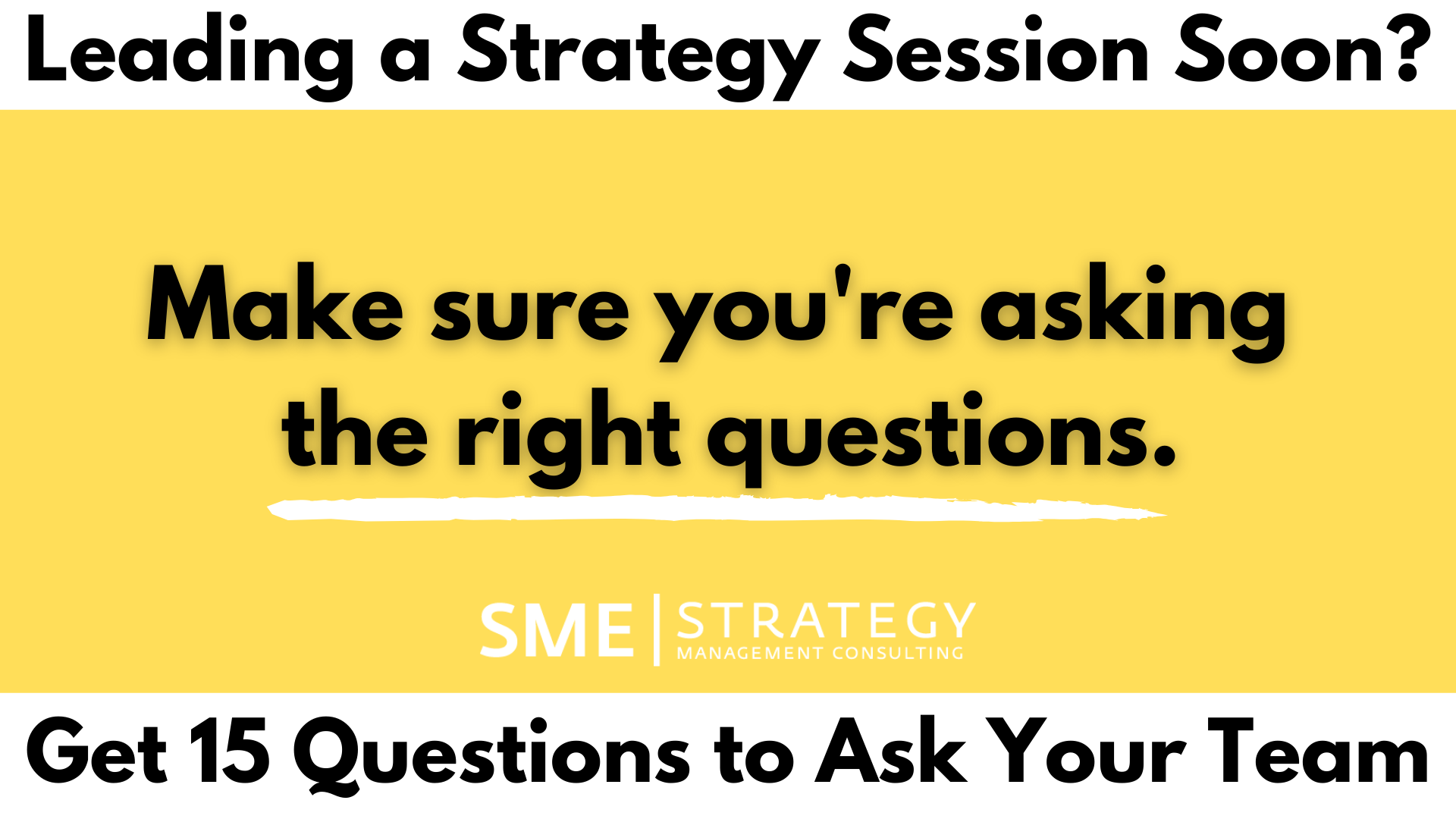
SME Strategy is a strategy consulting company that specializes in aligning teams around their vision, mission, values, goals and action plans. Learn more about how we can help you and your team create a strategic plan with our strategic planning and implementation services.
Sudden changes, such as the current COVID-19 global health crisis has caused a disruption in every-day business, while many individuals and teams find themselves navigating new ways to work together effectively.
While Tuckman’s Stages of Team Development apply to newly formed teams, they also apply to teams that encounter new situations or experience abrupt change and disruption.
During each stage of group development (forming, storming, norming and performing), team members experience various issues (positive, negative and neutral), eventually leading them into the next stage. Depending on how effectively the team works together, they may move through the stages slowly or quickly. If a team becomes “stuck” in any one of these stages leading up to performing, there can be negative impacts on organizational culture and productivity.
With this unprecedented situation of office displacement due to COVID-19, it is critical for business leaders and managers to understand how these stages impact their teams, and how to help their people move through each of these stages during periods of extreme change.
> Watch below: Leading Change in 5 Slides
We can help you align your team around a clear vision, mission, values, goals and action plans,
so you can lead your organization more effectively and get better results.
Stage 1: Forming
Overview:
During the first stages of a new situation or crisis, teams will begin to adapt to new ways of working together. This can be a time of both uncertainty and excitement as new ways to work and collaborate emerge. During a crisis, each team member may also be facing individual challenges in addition to navigating their new work situation.
Best Practices During Times of Change:
In this stage, a people first approach is recommended. Make sure that each team member has what they need to work from their new environment, and work with them to address obstacles they may be facing in their personal lives. When moving from a physical office to virtual home offices, each team member’s situation may drastically differ. Some people may have children or house mates, while others may already have a home office set up - Check in with each person individually and make sure they have the support they need to function in their new environment. Once each person’s needs are addressed, it is important to discuss and establish team communication guidelines and expectations as well as conflict resolution strategies.
Stage 2: Storming
Overview:
During the second stage of team development, teams start to carry out their day-to-day tasks or implement projects. During this stage, stress and conflict may begin to arise between team members, especially if they are unsure of their roles or how they should be working together to implement tasks or projects.
Best Practices During Times of Change:
In this stage, a focus on adjustment and alignment is recommended. Goals and targets may need to be adapted to fit the new situation and marketplace, and teams will need to be aligned on how they will carry out daily tasks and projects. Leaders can foster alignment by engaging their teams in (virtual) daily stand-up style meetings and/or weekly team meetings to make sure that everyone is moving in the same direction, towards the same goals. If there is persistent group conflict, leaders may need to step in to help mediate the situation.
Need help with your strategic planning process? A facilitator can help:
Stage 3: Norming
Overview:
During the third stage of team development, communication improves, and the team starts to “gel”. Collaborative work is smoother, and there is a reduction in tension and conflict. When conflict arises, team members understand how to address it productively. In this stage, the team is becoming more aligned, moving towards implementing common goals.
Best Practices During Times of Change:
In this stage, a focus on supporting project management and business continuity is important. Additionally, leaders should continue to foster communication and alignment between team members. Where leadership may need to be more hands-on in previous stage, this is a stage where leaders may be able to take a step back, allowing their team to make more decisions, while still proactively checking in with each group member and the team on a regular basis.
Stage 4: Performing
Overview:
During the fourth stage of team development, the group becomes more confident, collaborative, motivated and self-sufficient. Teams will reach higher levels of productivity and innovation in this stage.
Best Practices During Times of Change:
Although leaders will still be involved with the group, they may take another step back, allowing the team to become more self-sufficient and autonomous. Rather than proactively checking in with each team member, they may wish to move to a virtual “open-door policy” where individuals or the group can reach out to them if they need anything.
Stage 5: Adjourning
Depending on the team or the project, groups may reach a fifth and final stage of group development: adjourning. This is the stage where projects and deliverables are wrapped up, and the team is either reassigned or begins a new project. More often than not, teams will cycle through these stages when new projects begin, or their situation changes. For example, when offices slowly begin to reopen (or develop a hybridized remote/in-person approach to work), the fully remote team will enter their adjourning phase. Upon commencing in-person work full-time, there is a chance that teams may work through some or all of the above stages again.
Developing a high-performing team during difficult times
Although our team at SME Strategy is familiar with remote work (we have team members in different cities in BC, and clients in Canada, USA and around the world) we have been moving through the stages of team development due to the global health crisis and rapid changes in global business practices.
Our team has moved from a hybridized virtual/in-person team to a fully remote team set up in our home offices, supporting our clients and their teams, each set up in their home offices. Now five weeks into the physical distancing recommendations, we have moved from the norming into the performing phase – and not without some struggles along the way.
Here are some of the situations we encountered individually and as a team, and how we overcame them, allowing us to move quickly through each of these stages:
-
Forming
The first two weeks working fully remote were difficult for all of us. Individually, we struggled with time management, communication expectations, uncertainty, anxiety, and reduced productivity.
We worked through this by increasing the regularity of our team meetings from once a week to twice a week. We recognized the increased integration between personal and work life that we were all facing, and openly discussed strategies to help us adjust to the new environment and new team dynamics.
-
Storming
During the third week of virtual work, we started to evaluate our tasks and goals, and become aligned on our work for the foreseeable future. We maintained regular communication and continued to meet twice weekly to keep up with communication and to address conflicts quickly should they arise.
We worked through the challenges in this phase by trying to focus on recognizing positive aspects of our new situation and group dynamics and brainstorming ways that we could be of service to others.
Some of the questions we asked ourselves to keep our team morale up were:
-
-
What do we like about working from home?
-
How can we support others on our team?
-
How can we help our clients to be more innovative in this environment?
-
What can we do to help others in our community and beyond?
-
-
-
Norming
When we arrived at the fourth week of working from home, our days began to feel normal, and we were working together more cohesively. We still met as a team twice weekly, but our first meeting was shortened to a half-hour check-in, with one longer mid-week meeting and team work session. We began to be more autonomous in our daily tasks, while still working cohesively on team projects and deliverables.
-
Performing
The fourth week of remote work rolled seamlessly into the fifth, and productivity began to improve for each of us individually and as a team. We moved from simply getting stuff done to having more innovative ideas for business continuity and future projects.
To support each other in this stage, we continue to have a weekly virtual work session. We make sure to check on how everyone is doing personally as well as professionally and make time to connect as people before diving into business. Each of us has had individual struggles and successes in our personal and work lives over the past week, and we continue to take the time to acknowledge these and to support each other moving forward.
Here are some individual challenges and takeaways from our team members during the first few weeks of the COVID-19 crisis:
Anthony
Challenges:
- Time management – figuring out what I have more time for and how to pivot different aspects of our business
- Helping our clients in a different manner – figuring out how to support different organizations in different sectors in this situation
Successes:
- Our clients have valued our work with them, especially over the past few week, which has been really rewarding during this challenging time
- Our team is working towards new opportunities online, and taking the opportunities to focus on where we can provide the most impact and value
Perks:
- Not having to commute, leaving more time to get things done
- Developing a new routine at home, with more consistency, better sleep and regular meals
- Spending more time with my wife, celebrating our 2-year anniversary and getting re-aligned on our future (Yes, we did strategic planning!)
- Finding ways to connect with friends online, such as playing poker online

Anthony & Erica's Shepherd's Pie - #ProductivityMeal
Anthony's online poker game with friends - #VirtualConnections
Jason
Challenges:
- Lacking a dedicated workspace in my apartment, and not getting to see the other people in our office
- The only person I see on a daily basis is my roommate. It’s been challenging not being able to see friends, family members and colleagues in person – the isolation has been challenging
Successes:
- Since we already have communication systems in place for remote work, the transition has been smooth for our team
- Without so many competing priorities, I’ve found time to take an online course, and I am reading more books. In particular, I’ve started a book that I wouldn’t normally attempt to read in a regular work week. The book is Infinite Jest, 1000 pages of irregular dialogue and confusing structure.
Perks:
- Not having to commute and being able to start the work day earlier
- I’ve been able to stick to a schedule of eating well, sleeping well, and staying active which has contributed to my overall wellbeing

Jason's peanut butter protein coffee - #ProductivityCoffee
Jenna
Challenges:
- During the first two weeks, productivity was a challenge for me. I’ve never struggled with productivity issues in the past, so this was a surprise. I’ve since developed some routines and systems to help me increase productivity while working from home.
- My husband is also working full-time from home, and we have a relatively small 2-bedroom apartment. Navigating the shared space has been a challenge, but we’ve started to work out the kinks.
Successes:
- My creative thinking has improved, and I’m starting to be more innovative at work and in my personal life – perhaps because there’s more time and space to try (and sometimes fail) at new things
Perks:
- Without the chaos of everyday life, I’ve started to slow down and try new things. I’ve gotten really into brewing premium coffee at home, since I don’t visit cafes regularly right now. I’m purchasing locally roasted beans (shout out to Discovery Coffee), grinding them at home, and experimenting with pour over and French press brewing techniques

Jenna's coffee set up - #CoffeeBreak
As a team, we recognize that we’ll continue to experience ups and downs, but collectively, we’re grateful that we’ve reached the performing phase, and are excited to help others do the same!
For information on our virtual training modules for remote teams,
visit our services page.
Looking to update your strategic plan?
Our course will guide you through each step of the process: 




